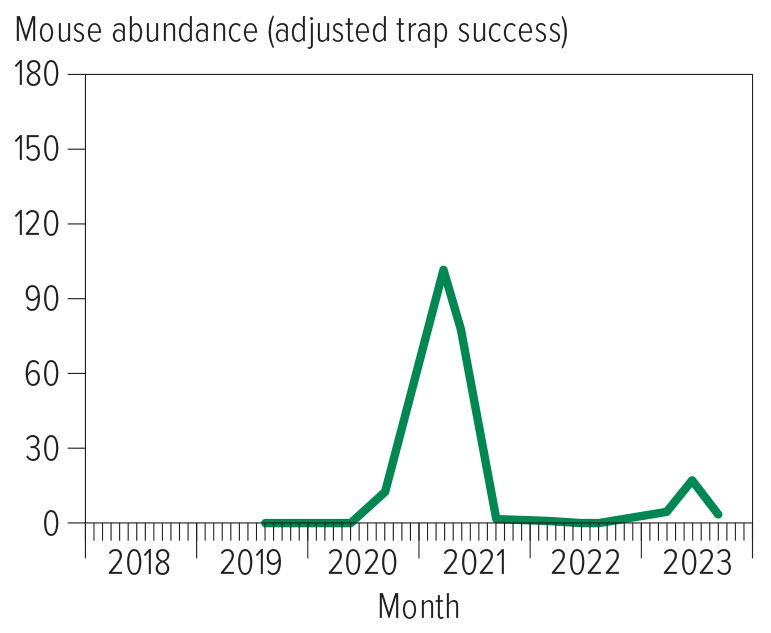Key points
- Mouse numbers across the northern region are low
- The mid-term prediction for a May 2024 outbreak is very low to low
- However, there are some instances of high and moderate activity
- It is critical that clean harvests and continued monitoring occur
Mouse numbers across the northern region are thankfully lower than the high populations experienced a few years ago. The mid-term prediction for a May 2024 outbreak is very low to low.
However, with some moderate activity recorded at one site, it is critical that clean harvests and continued monitoring occur.
The situation
Queensland’s monitored sites recorded low or no mouse activity. There was no activity at 13 sites across the southern, central and northern Darling Downs, and low or no activity across the Goondiwindi–Moonie region.
In New South Wales, mouse activity is generally low.
At Moree, there was low activity at one site and no activity at another eight sites.
At Parkes, there was no activity at nine sites. This was similar at Trangie’s two sites, Gin Gin’s 10 sites, and the 10 sites across the Liverpool Plains.
In the southern part of the state, there was moderate activity, at 75 burrows/ha at Coleambally, and low at another three sites.
There was no mouse activity at the nine sites in the Riverina.
Harvest clean and keep monitoring
CSIRO principal research scientist and rodent management team leader Dr Peter Brown says mouse monitoring should still be actively occurring.
“Although mouse numbers and activity are generally low, there are patches of low-to-moderate activity. And with crop yields likely to be average or high in many areas, mouse activity might be masked.”

Mouse numbers could rapidly increase when conditions become favourable. That is if good summer rains allow weeds to grow, providing food and cover.
“This can maintain mouse breeding throughout summer, which becomes a concern for seeding in autumn 2024.
“It is critical to harvest as cleanly as possible, avoiding grain loss, to ensure there is minimal high-quality food available for mice. Low background food will increase the chance that mice will encounter baits, if baiting is warranted.”
He says mouse chew cards are useful at this time of year to monitor mouse activity. “There is always a chance of isolated patches of higher mouse activity (masked by maturing crops).”
Baiting
If mouse damage is evident in maturing crops, zinc phosphide mouse bait can be applied.
However, this may not be possible and will depend on crop development and harvest timings.
Mice captured at CSIRO/NSW DPI benchmark site, Parkes, NSW.

Source: CSIRO Mouse Update, November 2023.There is a 14-day withholding period before harvest. Also, once seeds have developed on heads, mice are reluctant to go for zinc phosphide baits. Baiting is advised well before seed-set.
Dr Brown also suggests talking to bait suppliers and ask for 50 grams zinc phosphide per kilogram bait. This new dose will ensure the best chance of success.
“Be aware there may be supply lead times in some locations, so talk to your supplier.”
Results from CSIRO trials on the new bait strength are promising, showing significantly better outcomes are achieved using it.
The National Mouse Group has also received anecdotal reports of excellent baiting results using the new formulation. Where bait was applied in late winter there are low mouse numbers.
CSIRO mouse expert Steve Henry says the basics should still be top of mind.
“Baiting is just one component in management.”
Mouse Alert
To help map activity, mouse numbers should be reported using the Mouse Alert website.
Dr Brown says this helps other growers and researchers see what mouse activity is being observed in the region.
Information entered can be used to alert local biosecurity authorities and others about changes in mouse populations.
Community reports help researchers to assess trends in mouse activity, which can help to keep everyone informed about the likelihood of mouse problems. Landholders can be alerted to changes in mouse activity when number start to build.
More information: Mouse Alert website, @MouseAlert on X (formerly Twitter), GRDC Mouse Management Resources

























































